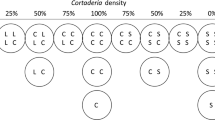Summary
Establishment of Plantago lanceolata and P. major ssp major among grass was studied in a field experiment in which survival and selection on date of seedling emergence and plant size was investigated in relation to the vegetation structure. P. major — in contrast to P. lanceolata — was not able to establish itself in grass because of its lower competitive ability caused by later germination, smaller seedling size, and shorter leaves. In both species there was selection for early germination. For P. lanceolata a significant correlation was found between the strength of selection and the light climate, determined by the structure of the grass sward. Plants that germinated early were at an advantage because they were larger, especially the leaves, when compared with plants that germinated late. It seems likely that selection was mainly by competition for light. Contrary to expectation P. major-seedlings had a higher shade tolerance than those of P. lanceolata. The performance of both species is discussed in relation to their different life strategies.
Similar content being viewed by others
References
Arnold SJ, Wade MJ (1984) On the measurement of natural and sexual selection: theory. Evolution 38:709–719
Arthur AE, Gale JS, Lawrence KJ (1973) Variation in wild populations of Papaver dubium. VII Germination time. Heredity 30:189–197
Baskin JM, Baskin CC (1972) The influence of germination date on survival and seed production in a natural population of Leavenworthia stylosa. Am Midl Natur 88:318–323
Bassett IJ, Crompton CW (1975) The biology of Canadian weeds. 11. Ambrosia artemisiifolia L. and A. psilostachya DC. Can J Plant Sci 55:463–476
Bassett IJ, Crompton CW (1978) The biology of Canadian weeds. 32. Chenopodium album L. Can J Plant Sci 58:1061–1072
Berendse F (1983) Interspecific competition and niche differentiation between Plantago lanceolata and Anthoxanthum odoratum in a natural hayfield. J Ecol 71:379–390
Bishop YMM, Fienberg SE, Holland PW (1975) Discrete Multivariate Analysis: Theory and Practice. M.I.T. Press, Cambridge, USA
Blom CWPM (1978) Germination, seedling emergence and establishment of some Plantago species under laboratory and field conditions. Acta Bot Neerl 27:257–271
Blom CWPM (1979) Effects of trampling and soil compaction on the occurrence of some Plantago species in coastal sand dunes. Doct. thesis, Nijmegen, The Netherlands
Cook RE (1980) Germination and size-dependent mortality in Viola blanda. Oecologia (Berlin) 47:115–117
During HJ, Schenkeveld AJ, Verkaar HJ, Willems JH (1985) Demography of short-lived forbs in chalk grassland in relation to vegetation structure. In: White J (ed) The Population Structure of Vegetation. Dr W. Junk Publ., Dordrecht, pp 341–370
Endler JA (1986) Natural Selection in the Wild. Princeton Univ. Press, Princeton, N.J.
Falconer DS (1981) Introduction to Quantitative Genetics. 2nd Ed. Longman, London, UK
Fenner M (1978a) A comparison of the abilities of colonizers and closed-turf species to establish from seed in artificial swards. J Ecol 66:953–963
Fenner M (1978b) Susceptibility to shade in seedlings of colonizing and closed-turf species. The New Phytologist 81:739–744
Fowler N (1984) The role of germination date, spatial arrangement, and neighbourhood effects in competitive interactions in Linum. J Ecol 72:307–318
Gleason HA, Cronquist A (1963) Manual of Vascular Plants of Northeastern United States and Adjacent Canada. Van Nostrand CY, Princeton, NJ
Grime JP, Jeffrey DW (1965) Seedling establishment in vertical gradients of sunlight. J Ecol 53:621–642
Grubb PJ (1982) Control of relative abundance in roadside Arrhenatheretum: results of a long-term garden experiment. J Ecol 70:845–861
Hitchcock CL, Cronquist A, Ownsbey M, Thompson JW (1969) Vascular Plants of the Pacific Northwest, Part 1–5. Univ. of Washington Press, Seattle
Hutchinson TC (1967) Comparative study of the ability of species to withstand prolonged periods of darkness. J Ecol 55:291–299
Kalisz S (1986) Variable selection on the timing of germination in Collinsia verna (Scrophulariaceae). Evolution 40:479–491
Lande R, Arnold SJ (1983) The measurement of selection on correlated characters. Evolution 37:1210–1226
Marks M, Prince S (1981) Influence of germination date on survival and fecundity in wild lettuce Lactuca serriola. Oikos 36:326–330
Miller TE (1987) Effects of emergence time on survival and growth in an early old-field plant community. Oecologia (Berlin) 72:272–278
Pons TL, Van der Toorn J (1988) Establishment of Plantago lanceolata L. and Plantago major L. among grass. I. Significance of light for germination. Oecologia (Berlin) 75:394–399
Poorter H, Lewis C (1986) Testing differences in relative growth rate: a method avoiding curve fitting and pairing. Physiologia Plantarum 67:223–226
Ross MA, Harper JL (1972) Occupation of biological space during seedling establishment. J Ecol 60:77–88
Sagar GR, Harper JL (1961) Controlled interference with natural populations of Plantago lanceolata, P. major and P. media. Weed Research 1:163–176
Sagar GR, Harper JL (1964) Biological Flora of the British Isles. Plantago major L., P. media L., and P. lanceolata L. J Ecol 52:189–221
Van der Toorn J, Ten Hove HJ (1982) On the ecology of Cotula coronopifolia L. and Ranunculus sceleratus L. II. Experiments on germination, seed longevity, and seedling survival. Oecologia Plantarum 3:409–418
Van Groenendael J (1985) Selection for different life histories in Plantago lanceolata. Doct. thesis, Wageningen, The Netherlands
Verkaar HJ, Schenkeveld AJ (1985) On the ecology of short-lived forbs in chalk grassland: seedling development under low photon flux density conditions. Flora 175:135–141
Watkinson AR (1978) The demography of a sand dune annual: Vulpia fasciculata. II. The dynamics of seed populations. J Ecol 66:35–44
Werner PA, Soule JD (1976) The biology of Canadian weeds. 18. Potentilla recta L., P. norvegica L., and P. argentea L. Can J Plant Sci 56:591–603
White J, Harper JL (1970) Correlated changes in plant size and number in plant populations. J Ecol 66:15–34
Author information
Authors and Affiliations
Additional information
Grassland species research group publication no 142
Rights and permissions
About this article
Cite this article
van der Toorn, J., Pons, T.L. Establishment of Plantago lanceolata L. and Plantago major L. among grass. Oecologia 76, 341–347 (1988). https://doi.org/10.1007/BF00377027
Received:
Issue Date:
DOI: https://doi.org/10.1007/BF00377027




